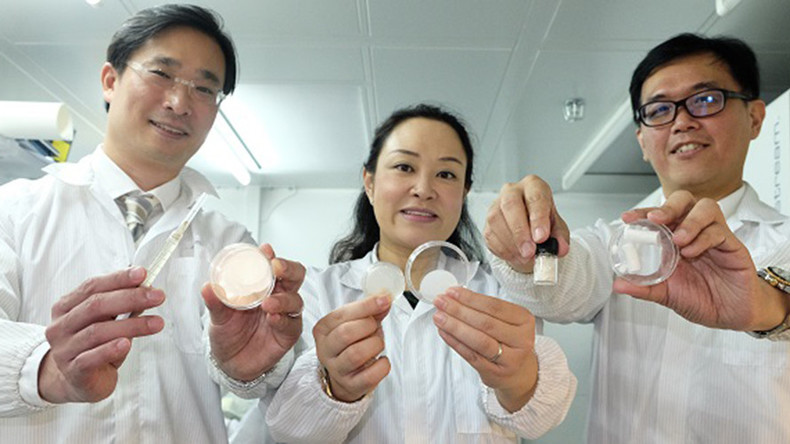https://www.rt.com/news/404579-skin-healing-fat-patch/
Healing patch from patient’s fat could soon be used to treat burn victims, researchers say
Published time: 25 Sep, 2017 23:57 Edited time: 26 Sep, 2017 07:06
Get short URL

Dr Marcus Wong, Assoc Prof Cleo Choong and Assoc Prof Andrew Tan © Nanyang Technological University
Scientists in Singapore have developed a radical new skin-healing patch using the body fat of liposuction patients – a product that could one day help aid the recovery of burn victims and diabetic patients.
Scientists in Singapore have developed a radical new skin-healing patch using the body fat of liposuction patients – a product that could one day help aid the recovery of burn victims and diabetic patients.
Assistant professor Cleo Choong, of the School of Materials Science and Engineering at Nanyang Technological University (NTU), pioneered the experiments that involved putting fat tissue through a battery of centrifuges, filters and gas chambers to extract a healing protein known as Angiopoietin-like 4 (ANGPTL4).
The ANGPTL4 reduces the effect of scleraxis, a gene that causes skin fibres in healing wounds to heal parallel to one another rather than as a mesh, turning wounds into layered scar tissue, says associate professor Andrew Tan, one of the project’s leaders.
‘Gamechanger’: Scientists edit human embryo to unlock ‘crucial’ gene https://t.co/glFfVAhjT4
— RT (@RT_com) September 22, 2017
“It could mean that, in future, a surgeon can use the patient's fat and turn it into a healing agent on the spot, to promote faster recovery of the patient's wounds after an operation," Choong said in a statement.
Testing on lab mice has shown promising results.
The miracle protein not only makes scars less visible, but decreases inflammation, strengthens skin, closes wounds and encourages the formation of blood vessels. Those animals treated with ANGPTL4 healed twice as fast from normal wounds compared to untreated mice. Rodents with diabetic lesions healed three times as fast.
Choong and her colleagues hope their work, which has been published in the journal Scientific Reports, will lead to the large-scale production of gel patches and creams that can be administered by a doctor, or even at home.
'Older hearts could be rejuvenated with stem cells from younger ones' – study https://t.co/bUWvQPJ9Q5pic.twitter.com/fInjd8WGVF
— RT (@RT_com) August 15, 2017
Choong said: “We have developed ways to package ANGPTL4 into easy-to-use formulations such as gel patches, topical creams and injectable microcapsules. This will make it easy for doctors and even patients to use in future, should the product be made available to the market.”
The team estimates that it could be as little as five years until the product is available commercially, but will first have to conduct further laboratory trials.
The project is being carried out in conjunction with Dr Marcus Wong, a former senior consultant at Tan Tock Seng Hospital’s Plastic Surgery Service. Dr Wong provides the group with samples of body fat taken from his liposuction patients.
Healing patch from patient’s fat could soon be used to treat burn victims, researchers say
Published time: 25 Sep, 2017 23:57 Edited time: 26 Sep, 2017 07:06
Get short URL

Dr Marcus Wong, Assoc Prof Cleo Choong and Assoc Prof Andrew Tan © Nanyang Technological University
Scientists in Singapore have developed a radical new skin-healing patch using the body fat of liposuction patients – a product that could one day help aid the recovery of burn victims and diabetic patients.
Scientists in Singapore have developed a radical new skin-healing patch using the body fat of liposuction patients – a product that could one day help aid the recovery of burn victims and diabetic patients.
Assistant professor Cleo Choong, of the School of Materials Science and Engineering at Nanyang Technological University (NTU), pioneered the experiments that involved putting fat tissue through a battery of centrifuges, filters and gas chambers to extract a healing protein known as Angiopoietin-like 4 (ANGPTL4).
The ANGPTL4 reduces the effect of scleraxis, a gene that causes skin fibres in healing wounds to heal parallel to one another rather than as a mesh, turning wounds into layered scar tissue, says associate professor Andrew Tan, one of the project’s leaders.
‘Gamechanger’: Scientists edit human embryo to unlock ‘crucial’ gene https://t.co/glFfVAhjT4
— RT (@RT_com) September 22, 2017
“It could mean that, in future, a surgeon can use the patient's fat and turn it into a healing agent on the spot, to promote faster recovery of the patient's wounds after an operation," Choong said in a statement.
Testing on lab mice has shown promising results.
The miracle protein not only makes scars less visible, but decreases inflammation, strengthens skin, closes wounds and encourages the formation of blood vessels. Those animals treated with ANGPTL4 healed twice as fast from normal wounds compared to untreated mice. Rodents with diabetic lesions healed three times as fast.
Choong and her colleagues hope their work, which has been published in the journal Scientific Reports, will lead to the large-scale production of gel patches and creams that can be administered by a doctor, or even at home.
'Older hearts could be rejuvenated with stem cells from younger ones' – study https://t.co/bUWvQPJ9Q5pic.twitter.com/fInjd8WGVF
— RT (@RT_com) August 15, 2017
Choong said: “We have developed ways to package ANGPTL4 into easy-to-use formulations such as gel patches, topical creams and injectable microcapsules. This will make it easy for doctors and even patients to use in future, should the product be made available to the market.”
The team estimates that it could be as little as five years until the product is available commercially, but will first have to conduct further laboratory trials.
The project is being carried out in conjunction with Dr Marcus Wong, a former senior consultant at Tan Tock Seng Hospital’s Plastic Surgery Service. Dr Wong provides the group with samples of body fat taken from his liposuction patients.
